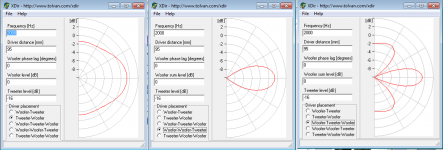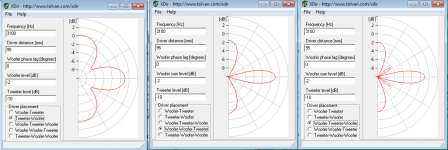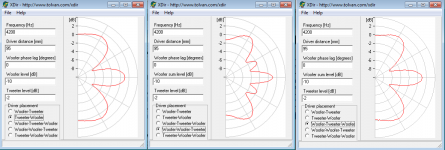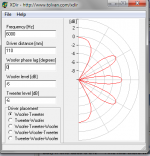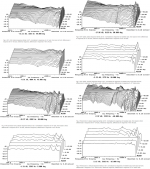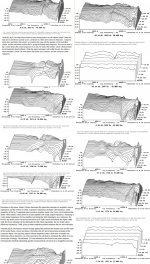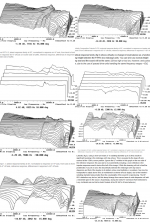Here is Stereophile's test of Snell XA tower
"Four-way floorstanding loudspeaker with 7-element "eXpanding Array" line source and rear-firing tweeter. Drive-units: two 1" (25mm) titanium-dome tweeters (one front, one rear), two 4.5" (112mm) midrange drivers, four 8" (205mm) reflex-loaded, black-anodized aluminum-cone woofers. (Alternate ports and port blanking plates are supplied.) Crossover frequencies: 300Hz, 2.4kHz (9kHz for rear tweeter). Crossover slopes: second-order electrical, fourth-order acoustical."
Estimating from the picture, M to T distance is around 100mm.
They don't have a horizontal measurement but the vertical polar start dropping at 1,5 to 2kHz at 10¤, quite severe at 20¤. Atkinson says that this is rather good for a mtm.
By the way D'Appolito first used BW3 but moved to LR4 xo for MTMs.
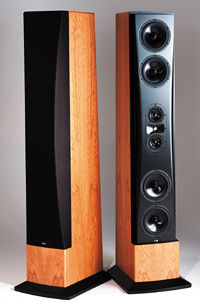
And this is my AINOgradient
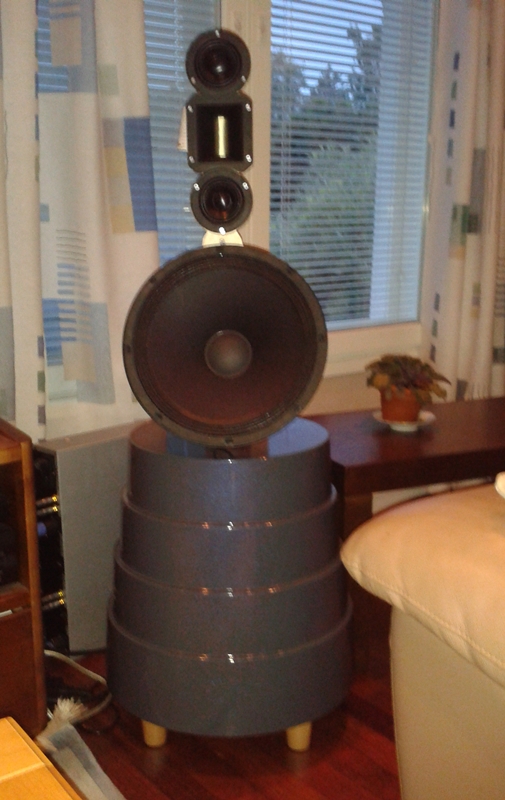
"Four-way floorstanding loudspeaker with 7-element "eXpanding Array" line source and rear-firing tweeter. Drive-units: two 1" (25mm) titanium-dome tweeters (one front, one rear), two 4.5" (112mm) midrange drivers, four 8" (205mm) reflex-loaded, black-anodized aluminum-cone woofers. (Alternate ports and port blanking plates are supplied.) Crossover frequencies: 300Hz, 2.4kHz (9kHz for rear tweeter). Crossover slopes: second-order electrical, fourth-order acoustical."
Estimating from the picture, M to T distance is around 100mm.
They don't have a horizontal measurement but the vertical polar start dropping at 1,5 to 2kHz at 10¤, quite severe at 20¤. Atkinson says that this is rather good for a mtm.
By the way D'Appolito first used BW3 but moved to LR4 xo for MTMs.

And this is my AINOgradient

Last edited:
More Xdir simulations...
First only mids at 200Hz m to m distance 190mm (2x95)
Then mt vs mmt vs mtm with xo at 3600Hz (L/2) sim at 3000, 36000 and 4200Hz respective levels of drivers.
First only mids at 200Hz m to m distance 190mm (2x95)
Then mt vs mmt vs mtm with xo at 3600Hz (L/2) sim at 3000, 36000 and 4200Hz respective levels of drivers.
Attachments
The sizing simulations you were performing in the other thread showed the 10f to be too small and inefficient to meet your objectives for the speaker. It is also rather expensive if you buy two. I am curious why you did not opt for a more appropriately sized (given your objectives) 5.25" midrange in either standard priced or expensive flavours. Is the dominant factor that the 10f has received a number of positive statements whereas the 5.25" drivers have received relatively few?I'm considering having two mids in my active 3-way, because i like all the highly positive comments on the small scanspeak 10F, but would like a bit more power handling. They'll be sealed (or just possibly ported), not dipole.
What is your reasoning for considering porting a midrange?
Back to Snell XA, this is what designer David tells abou mtm
"Smith said that for speaker design he uses "a very complete system and crossover simulator. It takes driver magnitude and phase curves, driver impedances, crossover topologies, crossover values, and physical system layout to give an accurate system response simulation on- and off-axis." In the case of the XA90ps, the computer modeling smoothed the vertical dispersion to within 1dB variation through ±15 degrees. Outside that zone, the array's vertical polar pattern drops off by 4-5dB at 40 degrees, which reduces the energy that bounces off the floor or ceiling. Instead of the XA90ps's two 2.5" upper-midrange units bracketed by two 6.5" midbass drivers, the larger XA Reference has four 8" woofers—set at 4.3x and 6.8x the distance between the MTM units—to extend the Reference's smooth vertical dispersion pattern down to 60Hz.
"I tried a number of alternative schemes," said Smith, "but none of these alternative systems looked promising, so a more conventional symmetric array was settled on...The simulations showed that constant directivity came from having a constant element spacing relative to the crossover frequency. That is, if the highest crossover frequency is six times the next crossover frequency, the mid-to-tweeter spacing should be one sixth the woofer-to-tweeter spacing. Both of these spacings should be one third (at most, one half) the crossover wavelength. In practice, this means the mids had to be placed very close physically to the tweeter, and the top crossover point should be as low as practical."
So, they use L/3 distance, for 2400Hz that is 143mm/3=47,6mm between M to T Wavelength frequency convert lambda Hz sound conversion acoustics acoustic audio radio speed of sound and radio typical waves wave length light vacuum equation formula for frequency speed of light color spectrum - sengpielaudio Sengpiel Berlin
But, but, if mid's flange diameter is 112mm, the calculations and words don't match! M to T center to center distanse of Snell XA must be some 90 -100mm!
There are hunders of MTM speakers (and WMTMW etc.) that don't match this L/3 or L/4 criterion. Many of them get excellent reviews. Somewhere must be a vague line that should not be crossed - L/2?
Vertical window of +/-10¤ is generally most important (direct sound). At 30-45¤ nulling is actually beneficial, because it minimizes floor and ceiling reflections' energy. Power response seems to be relatively easy to make good despite of lobing.
"Smith said that for speaker design he uses "a very complete system and crossover simulator. It takes driver magnitude and phase curves, driver impedances, crossover topologies, crossover values, and physical system layout to give an accurate system response simulation on- and off-axis." In the case of the XA90ps, the computer modeling smoothed the vertical dispersion to within 1dB variation through ±15 degrees. Outside that zone, the array's vertical polar pattern drops off by 4-5dB at 40 degrees, which reduces the energy that bounces off the floor or ceiling. Instead of the XA90ps's two 2.5" upper-midrange units bracketed by two 6.5" midbass drivers, the larger XA Reference has four 8" woofers—set at 4.3x and 6.8x the distance between the MTM units—to extend the Reference's smooth vertical dispersion pattern down to 60Hz.
"I tried a number of alternative schemes," said Smith, "but none of these alternative systems looked promising, so a more conventional symmetric array was settled on...The simulations showed that constant directivity came from having a constant element spacing relative to the crossover frequency. That is, if the highest crossover frequency is six times the next crossover frequency, the mid-to-tweeter spacing should be one sixth the woofer-to-tweeter spacing. Both of these spacings should be one third (at most, one half) the crossover wavelength. In practice, this means the mids had to be placed very close physically to the tweeter, and the top crossover point should be as low as practical."
So, they use L/3 distance, for 2400Hz that is 143mm/3=47,6mm between M to T Wavelength frequency convert lambda Hz sound conversion acoustics acoustic audio radio speed of sound and radio typical waves wave length light vacuum equation formula for frequency speed of light color spectrum - sengpielaudio Sengpiel Berlin
But, but, if mid's flange diameter is 112mm, the calculations and words don't match! M to T center to center distanse of Snell XA must be some 90 -100mm!
There are hunders of MTM speakers (and WMTMW etc.) that don't match this L/3 or L/4 criterion. Many of them get excellent reviews. Somewhere must be a vague line that should not be crossed - L/2?
Vertical window of +/-10¤ is generally most important (direct sound). At 30-45¤ nulling is actually beneficial, because it minimizes floor and ceiling reflections' energy. Power response seems to be relatively easy to make good despite of lobing.
Andy19191,
for dipole function, the baffle (in this case the diameter of the nude driver) determines how high the dipole peak and nulll set. 5½" is good for power but one can't make it work dipolic above 1500Hz. This is why S Linkwitz and J Kreskowsky changed their desings to 4-way and use 4" upper mids. There is some discussion about excursion/distortion with their single drivers.
Now my 3" upper mid pair has high-pass at 800Hz LR2. If I use only one, it is safer to use LR4 xo there too. But, if we have three crossovers (4-way), we have a phase problem easily. LR4,LR2,LR4 at suitable distance is ideal for phase.
Because I use minidsp for xo and parametric corrections, it so so easy for me to play with these!!!
My acoustic xo v7 (lower mid too hot aboce xo, must do more shelving peq)
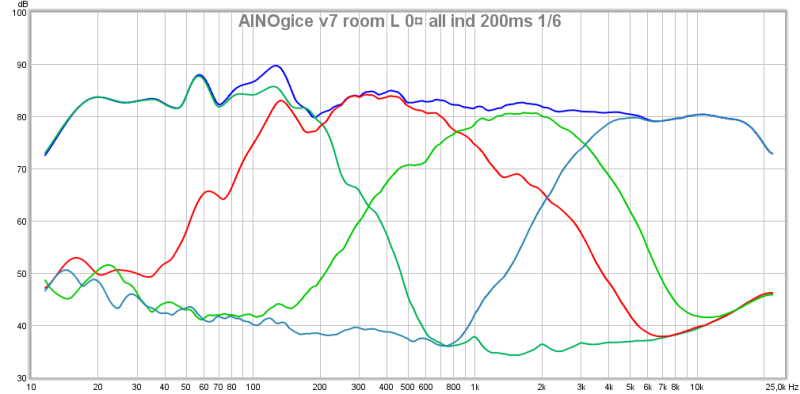
and John Kreskovsky's NaO Note II RS xo simulation. Here is his considerations of it and power handling of S10F. At a LX521 thread he critisized SL for driving his upper mid too hot at low Fq...
I am fiddling with this same problemacy with much less understanding and mathematical skills!!!
for dipole function, the baffle (in this case the diameter of the nude driver) determines how high the dipole peak and nulll set. 5½" is good for power but one can't make it work dipolic above 1500Hz. This is why S Linkwitz and J Kreskowsky changed their desings to 4-way and use 4" upper mids. There is some discussion about excursion/distortion with their single drivers.
Now my 3" upper mid pair has high-pass at 800Hz LR2. If I use only one, it is safer to use LR4 xo there too. But, if we have three crossovers (4-way), we have a phase problem easily. LR4,LR2,LR4 at suitable distance is ideal for phase.
Because I use minidsp for xo and parametric corrections, it so so easy for me to play with these!!!
My acoustic xo v7 (lower mid too hot aboce xo, must do more shelving peq)
and John Kreskovsky's NaO Note II RS xo simulation. Here is his considerations of it and power handling of S10F. At a LX521 thread he critisized SL for driving his upper mid too hot at low Fq...
I am fiddling with this same problemacy with much less understanding and mathematical skills!!!

An externally hosted image should be here but it was not working when we last tested it.
I think we might be at cross-purposes. The OP would need only one 5.25" driver to meet the objectives for his speaker and not two 4" drivers. Crossover to as-yet-undefined tweeter closer to 2k than 3k. I understood the OP had stated he was considering a conventional sealed configuration and not a dipole.Andy19191, for dipole function, the baffle (in this case the diameter of the nude driver) determines how high the dipole peak and nulll set. 5½" is good for power but one can't make it work dipolic above 1500Hz.
andy, exactly! I hijacked this thread with his acception, because our questions are still basically the same (distance between centerpoints in mt mmt or mtm and how to set xo)
In a closed box 3-way there is no sense in using 5½" mid because of it's dipersion. But, if one uses a 2½ - 4 inc mid there will be lobing problems wit a highish xo. JK uses 6kHz LR4 xo from upper mid to Tweet in Note II RS. There is lots of lobing that high but obviously ear isn't so sensitive to it then. His M to T distance is around 110mm, and it looks like this in xdir
I actually considered SEAS 12 coaxial for uppermid+tweet, but chose NeCD3.5H for it's high and even DI. My goal was o maximize horizontal DI. Also, the SEAS magnet structure is problematic for dipole.
I am not surprised to see so many coaxial mid-tweeter in latest designs (KEF, TAD, Genelec MDC etc.) That is a nice way to minimize lobing at high Fq
In a closed box 3-way there is no sense in using 5½" mid because of it's dipersion. But, if one uses a 2½ - 4 inc mid there will be lobing problems wit a highish xo. JK uses 6kHz LR4 xo from upper mid to Tweet in Note II RS. There is lots of lobing that high but obviously ear isn't so sensitive to it then. His M to T distance is around 110mm, and it looks like this in xdir
I actually considered SEAS 12 coaxial for uppermid+tweet, but chose NeCD3.5H for it's high and even DI. My goal was o maximize horizontal DI. Also, the SEAS magnet structure is problematic for dipole.
I am not surprised to see so many coaxial mid-tweeter in latest designs (KEF, TAD, Genelec MDC etc.) That is a nice way to minimize lobing at high Fq
Attachments
Last edited:
For example, what is wrong with the dispersion of the JBL LSR6332?In a closed box 3-way there is no sense in using 5½" mid because of it's dipersion.
But is the moving cone modulating the high frequency output nice?I am not surprised to see so many coaxial mid-tweeter in latest designs (KEF, TAD, Genelec MDC etc.) That is a nice way to minimize lobing at high Fq
Perhaps it would be better to use a fixed waveguide to avoid the modulation issue, gain better control over the dispersion, allow a different horizontal and vertical dispersion at the cost of worse vertical dispersion at larger angles?
A correction from my previous comments. It absolutely needs to be ¼ wavelength CtC distance at the -3dB down @60° for the mids.
The crossover frequency is determined by the physical size of the driver. This can be found at the -6dB down point @ 60° off axis.
In my case using 6.5" drivers this works out to be ~210mm CtC spacing for the mids leaving a space of 46mm for the tweeter. Crossed at 2.2kHz eg -6dB @60°. The frames are truncated which helps give me this much. I can remove a bit of material gaining me upto 6mm eg from 46mm to 52mm, still not much room to work with. Takes a smaller tweeter to pull off or compensated for by truncating the frame or by other means.
Looking at the pdf for your NE95's these should be spaced ~144mm CtC. This leaves a gap for a tweeter of ~49mm with a crossover point of 4.8kHz. Use EQ to balance the D'Appolito forwardness below 3.6kHz. This can be done in reverse, boost around 3.6kHz to match the level and then lower them both to match the tweeter.
Easy peasy with the MiniDSP.
Another way to test this is to take both mids and stick them to a narrow board with double sided foam tape (carpet tape) on the magnets spaced 144mm. No tweeter or crossover is necessary for this test. Done outdoors at a distance of at least 1meter if not two for accurate polar measurement where we know the two would be summed.
The crossover frequency is determined by the physical size of the driver. This can be found at the -6dB down point @ 60° off axis.
In my case using 6.5" drivers this works out to be ~210mm CtC spacing for the mids leaving a space of 46mm for the tweeter. Crossed at 2.2kHz eg -6dB @60°. The frames are truncated which helps give me this much. I can remove a bit of material gaining me upto 6mm eg from 46mm to 52mm, still not much room to work with. Takes a smaller tweeter to pull off or compensated for by truncating the frame or by other means.
Looking at the pdf for your NE95's these should be spaced ~144mm CtC. This leaves a gap for a tweeter of ~49mm with a crossover point of 4.8kHz. Use EQ to balance the D'Appolito forwardness below 3.6kHz. This can be done in reverse, boost around 3.6kHz to match the level and then lower them both to match the tweeter.
Easy peasy with the MiniDSP.
Another way to test this is to take both mids and stick them to a narrow board with double sided foam tape (carpet tape) on the magnets spaced 144mm. No tweeter or crossover is necessary for this test. Done outdoors at a distance of at least 1meter if not two for accurate polar measurement where we know the two would be summed.
Andy,
JBL doesn't show regular off-axis measurements, only some summed graphs. It is impossible to compare it to others measured differently.
Constant/controlled/uniform directivity and level of it horizontally and to seme extent vertically is now generally understood as fundamental information of a speaker's "quality".
There are many ways to make this happen - Horns, waveguides, baffle width, driver membrane width, all must match. With multiway speakers we can't avoid lobing diffractions unless we use brickwall filters or coaxial arrangement. A fullrange coaxial is very diffcult - synergy horn is perhaps the best.
A design of a consumer speaker (small rooms) has many many aspects and priorisations. In addition to above- distortion, efficiency, impedance swing, phase match, group delay, max spl/power handling etc.
A single fullrange is good in many theoetical aspects but very poor in practise. A two-way with a horn tweeter ala Geddes is excellent but there is discussion of horn colorations and diffractions. A 4-way partly dipole (like Linkwitz LX521, NAo Note, AINOgradient have strong directivity index (DI) but difficulties in constantness of it and interdriver lobing issues. Boxed 3-way speakers usually aim for low DI and don't use waveguides. xo and lobing is more easily handled. Small form factor 2-ways with waveguides are somewhat alike but lack bass.
Speaker R&D has been done for more than a century and we still don't have an overall winner. Speakers and a small room make a system and both must be considered simultaneously.
To Greebster - I must make a test baffle for these studies and experiments. I have done lots of horizontal measurements and overlays but I will do more verticals too, and with varying horizontal angle!
Genelec 8260 is hard to beat!
JBL doesn't show regular off-axis measurements, only some summed graphs. It is impossible to compare it to others measured differently.
Constant/controlled/uniform directivity and level of it horizontally and to seme extent vertically is now generally understood as fundamental information of a speaker's "quality".
There are many ways to make this happen - Horns, waveguides, baffle width, driver membrane width, all must match. With multiway speakers we can't avoid lobing diffractions unless we use brickwall filters or coaxial arrangement. A fullrange coaxial is very diffcult - synergy horn is perhaps the best.
A design of a consumer speaker (small rooms) has many many aspects and priorisations. In addition to above- distortion, efficiency, impedance swing, phase match, group delay, max spl/power handling etc.
A single fullrange is good in many theoetical aspects but very poor in practise. A two-way with a horn tweeter ala Geddes is excellent but there is discussion of horn colorations and diffractions. A 4-way partly dipole (like Linkwitz LX521, NAo Note, AINOgradient have strong directivity index (DI) but difficulties in constantness of it and interdriver lobing issues. Boxed 3-way speakers usually aim for low DI and don't use waveguides. xo and lobing is more easily handled. Small form factor 2-ways with waveguides are somewhat alike but lack bass.
Speaker R&D has been done for more than a century and we still don't have an overall winner. Speakers and a small room make a system and both must be considered simultaneously.
To Greebster - I must make a test baffle for these studies and experiments. I have done lots of horizontal measurements and overlays but I will do more verticals too, and with varying horizontal angle!
Genelec 8260 is hard to beat!
Attachments
Last edited:
This is something that I cannot stand to hear. Modulates the HF far too much for my tastes. There is one exception, Tannoy drivers do much better in this regard.But is the moving cone modulating the high frequency output nice?
Are you thinking of something like the E-JMLC 1000?Perhaps it would be better to use a fixed waveguide to avoid the modulation issue, gain better control over the dispersion, allow a different horizontal and vertical dispersion at the cost of worse vertical dispersion at larger angles?
Kev06, I haven't forgot about you too. Will see what I can come up with tomorrow (or is that today already? lets find out... post 🙂
I'll mix the table a little more with Xdir simulations. This time I change Woofer phase lag. Promblem is that I have no idea which phase lag is appropriate for each case - does anyone know how it is determined for these simulations?
Here m-t distance is 100mm (for Kev06) mt mmt and mtm configurations and xo at benign 2000Hz LR4 (-6db at xo).
edit: I noticed that I toggled tm instead of mt - the graph is upside down!
Here m-t distance is 100mm (for Kev06) mt mmt and mtm configurations and xo at benign 2000Hz LR4 (-6db at xo).
edit: I noticed that I toggled tm instead of mt - the graph is upside down!
Attachments
Last edited:
I had some more spare time and I explored Equipment Reviews | Stereophile.com and made some collashes of normalized directivity of different types of speakers. Horizontals are all 0-90¤ but verticals scale varies 5¤ to 90¤.
Coaxials consistently show best vertical dispersion and MT worst. The MTMs are all quite good and have xos at around 1,7 to 2,5kHz.
Kev06, sorry I didn't find any wmmt or mmt speakers.
Coaxials consistently show best vertical dispersion and MT worst. The MTMs are all quite good and have xos at around 1,7 to 2,5kHz.
Kev06, sorry I didn't find any wmmt or mmt speakers.
Attachments
The integrated quantities Harman show are sensibly chosen to be informative and support their quantitative subjective loudspeaker studies. It is clear that the 5" mid is integrating fairly smoothly with the tweeter+waveguide in terms of dispersion.Andy,JBL doesn't show regular off-axis measurements, only some summed graphs. It is impossible to compare it to others measured differently.
What suggests this to you?A synergy horn is perhaps the best.
Excellent in what respects?A two-way with a horn tweeter ala Geddes is excellent but there is discussion of horn colorations and diffractions.
A winner in what respect?Speaker R&D has been done for more than a century and we still don't have an overall winner.
Speakers in the home are luxury goods and made to be sold. If Bose and the audiophile industry have taught us anything it is that to be successful you need to distinguish your product in some way and have good marketing. Technical performance is a minor consideration.
Pro-audio monitoring speakers where one might expect technical performance to be more strongly weighted do seem to be converging in terms of horizontal dispersion. The consensus seems to be that +/-30 degrees of, say, a K&H 0 500 is too narrow and most current speakers, like your Genelec, have opened up to more like +/-40-45 degrees. Vertical dispersion is narrower and also compromised by the separate drivers for the non-coaxial arrangements.
Perhaps consensus is not a winner but I would suggest it is a reasonable target for a DIY home audio speaker if that is what is being used in the recording process.
I was thinking of any speaker that used separate drivers and waveguide/s primarily for dispersion control. I do like the Econowave thing for what someone earlier was calling "party" speakers. Within the home I would look more to a 3 way + subs with waveguides on the tweeter and mid.Are you thinking of something like the E-JMLC 1000?
You can read these 3D plots? I have always viewed people that choose to obscure information with 3D qualitative plots like these instead of using simpler quantitatively useful 2D contour plots as making a statement about the information they are trying to communicate.Coaxials consistently show best vertical dispersion and MT worst. The MTMs are all quite good and have xos at around 1,7 to 2,5kHz.
My browser/time-zone says you posted this at around 5am, I was probably snoring loudly at the time 🙂Kev06, I haven't forgot about you too. Will see what I can come up with tomorrow (or is that today already? lets find out... post 🙂
Thats most kind and I'd certainly be interested, but I'm far less committed to this than Juhazi, so please don't spend too much time on it - it seems more appropriate for the thread to go Juhazi's way.
TBH when I first posted I didn't realise (by a long way) the complexities involved; its really interesting to learn about, but for me on my first build I think simplicity is important in maximising my chances of success, so theres a very good chance that on this occasion I'll settle for a different/single mid driver instead.
Cheers
kev
Andy, In psots above I've tried to compare different systems/arrangements, not spesific speakers.
Geddes Summa/Econowave type speakers are excellent horizontally, but I haven't seen many vertical plots. In theory they have all the good things to have controlled dispersion and other major paramethers are top quality too. I haven't heard any.
Synergy horn has very good range for a practically point-source speaker. However there are people who don't like them.
Pro monitors are designed for studios that have usually better acoustic treatment than at home. I believe that is easier to make a speaker that has low directivity and even directivity and power response than a high DI one.
About plots, I prefer non-normalized waterfall type plots. But we must try to learn read and compare different visualizations, sure. A 3D and spectrogram are almost the same to me. We must always check scales on x y and z axes!
Geddes Summa/Econowave type speakers are excellent horizontally, but I haven't seen many vertical plots. In theory they have all the good things to have controlled dispersion and other major paramethers are top quality too. I haven't heard any.
Synergy horn has very good range for a practically point-source speaker. However there are people who don't like them.
Pro monitors are designed for studios that have usually better acoustic treatment than at home. I believe that is easier to make a speaker that has low directivity and even directivity and power response than a high DI one.
About plots, I prefer non-normalized waterfall type plots. But we must try to learn read and compare different visualizations, sure. A 3D and spectrogram are almost the same to me. We must always check scales on x y and z axes!
I would agree that it is pretty much inevitable one or two things will not be quite right on the first attempt but growing ones knowledge sorting it out can be rewarding. Designing your speaker to have a removable front baffle may be wise as might leaning towards cheaper drivers from well established manufacturers. The £45 5.25" Scan-Speak 15M you mentioned might be a good choice combined with the similarly priced SEAS DXT waveguide tweeter to help with the dispersion control. 10" woofers tend to be a bit pricey and your SEAS L26ROY is not an overly expensive example although it looks a bit of subwoofer. This may be no bad thing since if the bug bites you could move it into it's own enclosure and use a more efficient woofer with less low frequency extension in the main speakers.TBH when I first posted I didn't realise (by a long way) the complexities involved; its really interesting to learn about, but for me on my first build I think simplicity is important in maximising my chances of success, so theres a very good chance that on this occasion I'll settle for a different/single mid driver instead.
- Status
- Not open for further replies.
- Home
- Loudspeakers
- Multi-Way
- Twin mids and lobing
